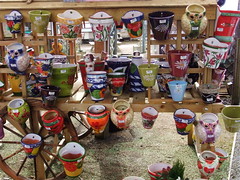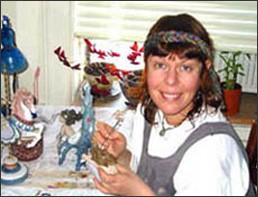Preparation
The first step is to thoroughly examine the damaged object to identify the what’s known as porcelain/ceramic body and decide how to approach the restoration process. If the damaged item has been previously restored, it may have glue residue or metal rivets still in place, the joints might be improperly aligned , or the restored parts may be either over-painted or over-glazed. So it is difficult to create a restoration map until all the previously restored parts have been cleaned.
When examining a broken ceramic object before repair, it is imperative that you have good lighting. You should also invest in a magnifying glass. At this stage of the process you’ll be looking for hairline cracks, chips, scrapes, and other damage that may not be clearly seen. Often the item is dirty and covered with glue or other adhesive material, which makes it difficult to see the damage.
How to Identify the Ceramic Body
“Ceramics” is a very general definition for all objects created from fired clay. Clays are composed of many various compounds. There are two kinds of clays: Primary clays and secondary clays.
Primary clays are formed when feldspar, a mineral found in the crust of the earth, decomposes, and hasn’t been affected by weathering. The purest form of primary clay is called kaolin. It is also known as “china clay” and is one of the most important ingredient in making porcelain. Secondary clays are those that have been affected by the elements (wind, water, etc.) and due to that have gathered a host of impurities. The properties of the clay can be modified by adding various components during the firing process. There are three different ceramic bodies that result from different ways of combining the above-mentioned components:
Porcelain, Earthenware, and Stoneware. For our purposes, however, let’s refer to a ceramic body as either “porous” or “non-porous.” The density of the porosity of the item will determine what type of cleaning solution will be applied and what type of glue or adhesive be used for bonding.
It’s not always easy to identify the body of the damaged item. But its weight and thickness is a good indicator. Soft-paste porcelain, for example, is lighter than hard-paste porcelain. It is also less dense. Examining the edge of a broken piece will help you see the porosity of the item before beginning the first stage of ceramic repair. Earthenware need to be glazed in order to make them resistance to water and other liquids. They’re also much more vulnerable to damage. The most easily recognized earthenware is the red-clay terracotta.
Unlike earthenware, stoneware items are sturdier and produce a ringing sound when tapped, but not nearly as loud as porcelain. The texture of stoneware has a combination of various crystals and other impure materials, which make them strong and low in porosity. A lot of American houseware items circa 19th century were made of stoneware.
Not every porcelain body is non-porous with glassy structure. Bone china, which is considered soft-paste porcelain, has a very dense structure but a porous body. Bone china got its name from “bone ash”, which is added to the mix and give it a very white “ceramic” color.
Hard-paste porcelain is strong, translucent, and gives off a ringing tone when tapped.
Because different ceramic bodies require different methods of restoration and different materials, it is important for anyone who wants to learn the art of ceramic repair to determine what type of body she has to work with before beginning the actual restoration.
A brief glossary of ceramic terms:
Bisque: A semi-porous material with granular structure that has been fired only once.
Bone China: The standard American and English porcelain. A very glassy, translucent soft-paste porcelain called “bone china” because of the addition of calcium phosphate (“bone ash”).
Ceramic: The Greek word “keramikes” means pottery. Any form of hard and brittle material made by firing clay. Today it’s a collective term that describes all clay products that have been fired.
Clay: A firm, earthy material which is soft when wet and which hardens when heated.
Earthenware: All pottery that hasn’t been vitrified. The first pottery ever made and is still very popular today. Earthenware is porous, low-fired, and opaque.
Firing: The heating of items in a kiln. Different temperatures produce different results.
Stoneware: Hard, non-porous and more durable than earthenware.




Speak Your Mind